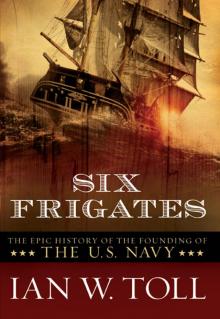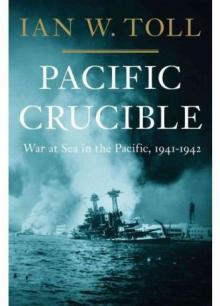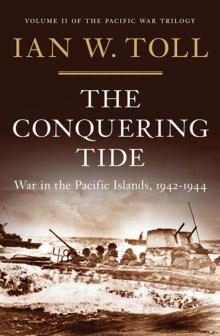- Home
- Ian W. Toll
Six Frigates
Six Frigates Read online
Praise for
SIX FRIGATES
Winner of the 2007 Samuel Eliot Morison Award and the 2007 William E. Colby Award
“In this account of the early history of the American navy, Ian Toll seeks to explain not just how [the War of 1812] happened, but also why. He succeeds splendidly. His factual story is as exciting as any of Patrick O’Brian’s fictional seafaring tales.”
—The Economist
“[Six Frigates is] rousing, exhaustively researched history…. Toll provides perspective by seamlessly incorporating the era’s political and diplomatic history into his superlative single-volume narrative—a must-read for fans of naval history and the early American Republic.”
—Publishers Weekly, starred review
“A fluent, intelligent history of American military policy from the early 1790s…but the book’s real value, and the pleasure it provides, lies in Toll’s grasp of the human dimension of his subject…. The battle depictions are worthy of Patrick O’Brian…Toll has plumbed diaries, letters and ships’ logs to give the reader a feel for the human quirks and harsh demands of life at sea in the Age of Sail…. [Toll] captures the zest for action that seized, and sometimes warped, young warriors on all sides.”
—Evan Thomas, New York Times Book Review (Editors’ Choice)
“Gripping…a masterful narrative…Toll captures the ambivalence of the government, and its reluctance to pay for even a tiny navy, very well.”
—Joe Mysak, Bloomberg News
“Toll has a light touch, much like noted historian David McCullough; well-researched facts are carefully balanced by smooth narrative flow…. The result is a thoroughly readable book that adds depth and significance to an important era of American history.”
—Bruce Linder, San Diego Tribune
“Sweeping in scope, full of vivid descriptions of naval battles and solidly grounded in the diplomatic landscape from the American Revolution through the War of 1812, Ian W. Toll’s Six Frigates is a masterly work…comprehensive, beautifully written and exciting to read. Every naval aficionado will want it.”
—Chris Pastilelis, Houston Chronicle
“A superb, page-turning history of America’s first truly difficult set of political military decisions…. A great, sprawling, and fascinating tale.”
—Admiral James Stavridis, U.S. Navy, Proceedings
“Ian W. Toll writes with an arresting energy. He evokes the world of Patrick O’Brian, the salt-stained ruthlessness of naval commanders, the carnage of the broadside and the surgeon’s saw, but also conjures a lost American landscape.”
—Tim Gardam, The Guardian (UK)
“Above all, Toll writes with clarity and force. This was a book I did not want to finish. It is a magnificent, riveting achievement.”
—Michael Pembroke, Sydney Morning Herald (Australia)
“Toll steers his readers handily through matters of policy and politics…. He quotes from piloting guides, considers the frigates’ sailing abilities, and remarks on spring fogs in Massachusetts Bay. He does not write that a ship headed offshore, but that it, the Chesapeake, ‘doubled Cape Henry and steered into the offing, dead east on the compass.’”
—Michael Kenney, Boston Globe
“Admirers of the late novelist Patrick O’Brian will relish Toll’s telling.”
—Nicholas Basbanes, Los Angeles Times Book Review
“Vibrant and comprehensive, Toll makes an impressive debut.”
—Gilbert Taylor, Booklist
“Toll’s account is unsparing in its treatment of political folly, administrative incompetence, and crippling personal rivalries…. And far from romanticizing the battles themselves, he provides graphic descriptions—very much in the style of [Patrick] O’Brian—of the frequently grotesque carnage produced by the naval fighting of this era.”
—Carnes Lord, professor of military and naval strategy, U.S. Naval War College, for the New York Sun
“This history will be a delight to fans of naval literature, fact or fiction.”
—Library Journal
SIX FRIGATES
SIX FRIGATES
The Epic History of the Founding of the U.S. Navy
Ian W. Toll
W. W. Norton & Company New York London
To my parents
Copyright © 2006 by Ian W. Toll
All rights reserved
Frontispiece: USS President entering the harbor of Marseilles.
Watercolor by Antoine Roux, c. 1805. New York Public Library. Part One: “Preparation for war to defend commerce.” The USS Philadelphia under construction in Joshua Humphreys’s shipyard, 1800. New York Public Library. Part Two: USS Constitution. Watercolor, 1819. Artist Unknown. The Mariners’ Museum, Newport News, Virginia. Part Three: USS Philadelphia on the rocks off Tripoli, October 31, 1803. Colored lithograph, P.S. Duval Son & Co., undated. The Mariners’ Museum, Newport News, Virginia.
For information about permission to reproduce selections from this book, write to Permissions, W. W. Norton & Company, Inc., 500 Fifth Avenue, New York, NY 10110
Library of Congress Cataloging-in-Publication Data
Toll, Ian W.
Six frigates: the epic history of the founding of the U.S. Navy / Ian W. Toll.
p. cm.
Includes bibliographical references.
ISBN: 978-0-393-33032-8
1. United States. Navy—History—18th century. 2. United States. Navy—History—19th century. 3. Frigates—United States—History—18th century. 4. Frigates—United States—History—19th century. 5. United States—History—Tripolitan War, 1801–1805—Naval operations. 6. United States—History—War of 1812—Naval operations. 7. United States—History, Naval—18th century. 8. United states—History, Naval—19th century. I. Title.
E182.T65 2006
359.00973'09033—dc22
2006020769
W. W. Norton & Company, Inc.
500 Fifth Avenue, New York, N.Y. 10110
www.wwnorton.com
W. W. Norton & Company Ltd.
Castle House, 75/76 Wells Street, London W1T 3QT
CONTENTS
Debts of Gratitude
Note on Language and Nautical Terminology
PART ONE
To Provide and Maintain
CHAPTER ONE
CHAPTER TWO
CHAPTER THREE
CHAPTER FOUR
PART TWO
To the Shores of Tripoli
CHAPTER FIVE
CHAPTER SIX
CHAPTER SEVEN
CHAPTER EIGHT
CHAPTER NINE
PART THREE
England Again
CHAPTER TEN
CHAPTER ELEVEN
CHAPTER TWELVE
CHAPTER THIRTEEN
CHAPTER FOURTEEN
CHAPTER FIFTEEN
Epilogue
Chronology of Later Events: 1815–2005
Notes
Bibliography
Nelson’s Funeral Procession on the Thames, January 9, 1806. Oil on canvas by Daniel Turner, 1807. National Maritime Museum, London.
Henry Knox by Gilbert Stuart, c. 1805. The Granger Collection, New York.
The southern live oak, Quercus virens. This native North American hardwood was a highly prized shipbuilding timber. Artist unknown, c. 1872. The Mariners’ Museum, Newport News, Virginia.
John Adams by Gilbert Stuart, c. 1800–15. Gift of Mrs. Robert Homans, National Gallery of Art, Washington, D.C.
Thomas Jefferson by Rembrandt Peale, 1805. Painted in the middle years of Jefferson’s presidency. Library of Congress.
USS Constellation capturing French frigate L’Insurgente, February 9, 1799. Watercolor by Irwan John Bevan. The Mariners’ Museum, Newport News, Virginia.
Tho
mas Truxtun. Oil on canvas by Orlando S. Lagman (after Bass Otis), 1965. U.S. Naval Historical Center, Washington, D.C.
Edward Preble, c. 1805–07. Artist unknown. U.S. Naval Academy, Annapolis, Maryland.
Chart of the Entrance to Chesapeake Bay, 1822. Engraving by William Hooker. New York Public Library.
William Bainbridge by John Wesley Jarvis, c. 1814. U.S. Naval Academy, Annapolis, Maryland.
City of Washington, D.C. Colored lithograph by Peter Anderson, 1838. The Mariners’ Museum, Newport News, Virginia.
USS Philadelphia on the rocks off Tripoli, October 31, 1803. Colored lithograph, P.S. Duval & Son, undated. The Mariners’ Museum, Newport News, Virginia.
Stephen Decatur, Jr. Oil on canvas by Orlando S. Lagman (after Gilbert Stuart), 1965. U.S. Naval Historical Center, Washington, D.C.
Burning of the USS Philadelphia in Tripoli Harbor, February 16, 1804. Nicolino Calyo (attributed), c. 1804. The Mariners’ Museum, Newport News, Virginia.
Preparation for War to Defend Commerce. The USS Philadelphia under construction in Joshua Humphreys’s shipyard, 1800. This hand-colored engraving by Thomas Birch significantly understates the actual dimensions of the vessel. New York Public Library.
Stephen Decatur in hand-to-hand combat with a Tripolitan gunboat captain, August 3, 1804. Engraving, 1857. The Mariners’ Museum, Newport News, Virginia.
USS President entering the harbor of Marseilles. The New York–built ship was deemed the fastest and finest of America’s early frigates. Watercolor by Antoine Roux, c. 1805. New York Public Library.
USS President setting sail. Engraving by Jean-Jérôme Baugean. National Maritime Museum, London.
James Madison by Gilbert Stuart, c. 1821. Ailsa Mellon Bruce Fund, National Gallery of Art, Washington, D.C.
Chart and Plan of the Harbour of New York, 1781. New York Public Library.
Naval surgical instruments: hacksaw, forceps, bone scraper, knives, artery clamp, suture hook, scalpels. U.S. Naval Historical Center, Washington, D.C.
Cat-o’-nine-tails. Two dozen lashes were said to reduce a man’s back to butcher’s meat. The Mariners’ Museum, Newport News, Virginia.
Isaac Hull. Oil on canvas by Orlando S. Lagman (after Gilbert Stuart), 1967. U.S. Naval Historical Center, Washington, D.C.
USS Constitution escaping from a British squadron, July 1812. Painting by F. Muller. U.S. Naval Historical Center, Washington, D.C.
USS Constitution capturing HMS Guerrière. Oil on canvas by Seymour Samuel, c. 1812–15. The Mariners’ Museum, Newport News, Virginia.
A Boxing Match, or Another Bloody Nose for John Bull. Etching with watercolor by William Charles, 1813. Library of Congress.
USS Constitution capturing HMS Java. Hand-colored lithograph by Nathanial Currier, 1846. Library of Congress.
Commodore Philip Broke, HMS Shannon, leads boarders onto the deck of USS Chesapeake, June 1, 1813. Engraving from Memoirs of Admiral Broke. U.S. Naval Historical Center, Washington, D.C.
USS President, the morning after her capture by a British squadron off New York, January 1815. Lithograph by Thomas Buttersworth. The Mariners’ Museum, Newport News, Virginia.
USS Constitution towing HMS Cyane, captured February 28, 1815. Artist unknown. Library of Congress.
Boston Harbor from Constitution Wharf. Robert Salmon, 1833. U.S. Naval Academy, Annapolis, Maryland.
USS Constitution, 1997. Photograph by Janet Stearns, courtesy of USS Constitution Museum, Boston.
DEBTS OF GRATITUDE
This book would have required at least twice as much time to write—and it might be more truthful to say it would not have been written at all—if not for the painstaking efforts of the Department of the Navy, beginning in the 1920s and continuing to this day, to collect, transcribe, and publish large numbers of early naval records, documents, journals, and letters. Three series merit special mention. Naval Documents Related to the Quasi-War Between the United States and France (7 vols.) is invaluable not only as a documentary history of the Quasi War, but for its attention to the construction and fitting out of the first frigates. Naval Documents Related to the United States Wars with the Barbary Powers (6 vols.) reaches back to the earliest debates of the 1780s, when American ships first fell prey to the Barbary corsairs, and provides a comprehensive day-to-day history of Commodore Edward Preble’s 1803–04 campaign against Tripoli. The Naval War of 1812: A Documentary History (3 vols. with a fourth in process) addresses not only the naval war itself but the Anglo-American disputes that preceded the war. The third volume, released in 2004, provides a wealth of newly published material on the 1814 operations in the Chesapeake Bay, including the invasion and destruction of Washington. Additional naval records and letters are kept at the National Archives, Record Group 45; and several collections of officers’ correspondence can be found at the New-York Historical Society and the Historical Society of Pennsylvania. The latter is the repository of Joshua Humphreys’s letter and account books, an essential source both for debates over the design of the frigates and for the construction and fitting out of the frigate United States.
American State Papers (38 vols.) provides many vital documents, particularly in the volumes for Foreign Relations, Finance, Commerce and Navigation, Military Affairs, and Naval Affairs. Annals of Congress provides a record of debates in the House. The Library of Congress Web site provides scanned original images of the Thomas Jefferson Papers, much of it text-searchable, with transcriptions by Paul Leicester Ford. (The Library’s site, at http://memory.loc.gov, also provides full-page access to American State Papers, Annals of Congress, and several other essential sources.) The Papers of Thomas Jefferson, an ongoing project at Princeton University Press, is the preferred source for Jefferson’s early career. Also useful are The Adams-Jefferson Letters (Lester J. Cappon, ed.) and The Republic of Letters: The Correspondence Between Thomas Jefferson and James Madison 1776–1826 (James Morton Smith, ed.). Most trade, economic, and fiscal statistics have been drawn from the U.S. Census Bureau’s Historical Statistics of the United States, Colonial Times to 1970 (2 vols.). Of the contemporary newspapers, the most essential are the Philadelphia Aurora General Advertiser (excerpted at length in Richard N. Rosenfeld’s American Aurora, 1997), the Niles’ Register, The Times of London, and the British Naval Chronicle.
For naval policy debates and politics during the pre–1815 era, two books merit special mention: Marshall Smelser’s Congress Founds the Navy (1959) and Craig Symonds’s Navalists and Anti-Navalists (1980). The importance of American merchant shipping interests is emphasized in Robert G. Albion and Jennie Barnes Pope’s Sea Lanes in Wartime (1942). The best overall work on the early American merchant marine is William Armstrong Fairburn’s Merchant Sail (1945–55). Howard Chapelle remains the leading American authority on ship design issues in the age of sail, even if most of his books are more than half a century old. I have particularly relied on The History of the American Sailing Navy: The Ships and Their Development (1949). Virginia Steele Wood’s Live Oaking: Southern Timber for Tall Ships (1981) relates the little-known history of the use of live oak as a ship’s timber. For ship-handling and seamanship, the best modern work I have found is John Harland’s Seamanship in the Age of Sail (1984).
Several naval biographies deserve mention. The best I have read from this era is Christopher McKee’s Edward Preble: A Naval Biography (1972). Also important are David F. Long’s Ready to Hazard: A Biography of Commodore William Bainbridge, 1774–1833 (1981), Albert Gleaves’s James Lawrence (1904), Eugene Ferguson’s Truxtun of the Constellation (1959), and Linda Maloney’s Captain from Connecticut: The Life and Naval Times of Isaac Hull (1986). Two biographies of Stephen Decatur, Jr., were published in 2004: A Life Most Bold and Daring, by Spencer Tucker, and A Rage for Glory, by James Tertius De Kay. Of the political biographies, I have relied particularly on David McCullough’s John Adams (2001), Dumas Malone’s Jefferson and His Time (1948–70), and Joseph Ellis’s several excellent works on the founders. For the politics
of the 1790s, no single work is more comprehensive than Stanley Elkins and Eric McKitrick’s monumental The Age of Federalism: The Early American Republic, 1788–1800 (1994). Two important sources on the Quasi War are Michael A. Palmer’s Stoddert’s War (1987) and Alexander DeConde’s The Quasi War: The Politics and Diplomacy of the Undeclared War with France, 1797–1801 (1966).
For general histories of the navy during the pre–1815 period, a seminal modern work is Christopher McKee’s A Gentlemanly and Honorable Profession: The Creation of the U.S. Naval Officer Corps, 1794–1815 (1991). Tyrone Martin’s A Most Fortunate Ship: A Narrative History of Old Ironsides (1980) is the definitive work on the frigate Constitution, written by one of her former commanders. William Fowler’s Jar Tars and Commodores (1984) is a good narrative history of the era between the Revolution and the War of 1812. For the Barbary Wars, there are several histories; none is more thorough than Glenn Tucker’s Dawn Like Thunder: The Barbary Wars and the Birth of the U.S. Navy (1963). Two accounts of captivity in Tripoli by members of the crew of the Philadelphia, one written by a surgeon and one by a sailor, appear in White Slaves, African Masters: An Anthology of American Barbary Captivity Narratives (Paul Baepler, ed., 1999).

 Six Frigates
Six Frigates Pacific Crucible: War at Sea in the Pacific, 1941-1942
Pacific Crucible: War at Sea in the Pacific, 1941-1942 The Conquering Tide
The Conquering Tide